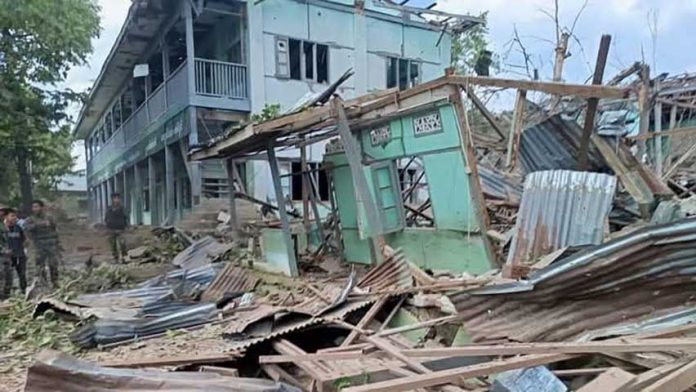Resistance forces in Thabeikkyin Township of Mandalay Region and Bhamo Township of Kachin State told DVB that 16 civilians were killed and nearly 40 others were injured by airstrikes on Yayhtwak village of Thabeikkyin and Nyaungpintha in Bhamo on May 7-8.
“The military intentionally attacked these civilians,” a member of a resistance group in Bhamo, allied with the Kachin Independence Army (KIA), told DVB on Thursday. The People’s Defense Force (PDF) under the National Unity Government (NUG) in Thabeikkyin told DVB that one civilian was killed and nine were injured by two airstrikes on Wednesday.
Thabeikkyin is located 90 miles (144 km) north of Mandalay and Bhamo is located 120 miles (193 km) south of the Kachin State capital Myitkyina. Attacks on these two areas of Myanmar came after the regime in Naypyidaw extended its ceasefire from May 6-31. Despite having let its ceasefire elapse the week of April 30 to May 5, it announced a unilateral extension without any response from the NUG, the PDF, or the KIA, last week.
“There will be no effective ceasefire unless there is an appropriate mechanism in place by impartial international monitoring and enforcement mechanism,” Kyaw Zaw, the NUG spokesperson, told DVB.
The NUG called for an international monitoring mechanism to document regime attacks on April 15, during its March 30 to April 20 ceasefire, except in cases of “self-defense” judged the PDF, which went on to seize Indaw Township of Sagaing Region from regime forces on April 7.
The regime first announced its ceasefire on April 2 – three days after the NUG – but since then it has killed 290 people and injured another 657 in over 489 air and artillery attacks, according to DVB data.
The U.N. reported that the regime has carried out over 489 attacks since the April 2 ceasefire began with 211 attacks being carried out on communities in central Myanmar, where the earthquake has killed 4,477 and injured 11,366, according to DVB data.
“It is imperative that the military immediately stop all attacks on civilians and civilian objects,” said Volker Türk, the U.N. human rights chief, in a statement on May 2. He called for a permanent halt to hostilities and a return to civilian rule in Myanmar.
Nyan Lynn Thit Analytica, an independent group researching conflict in Myanmar, has documented that the regime killed 201 civilians and injured over 300 in 244 airstrikes during the month of April.
The Brotherhood Alliance–comprised of the Ta’ang National Liberation Army (TNLA), the Myanmar National Democratic Alliance Army (MNDAA), and the Arakan Army (AA)-extended its March 30 ceasefire to May 31 in order to allow earthquake relief work to continue.
“The regime killed four civilians, including a five-year-old child, and injured seven others at a wedding ceremony in Thayatcho village of Nawnghkio Township,” the TNLA stated on Friday.
It claimed that regime forces have fired at least 100 rounds of artillery and dropped more than 30 bombs in air and drone strikes on areas under its control in northern Shan State and neighbouring Mandalay Region on May 6-9.
Lway Yay Oo, the TNLA spokesperson, told media on May 4 that the regime had intensified airstrikes and attacks following an unsuccessful second round of China-brokered ceasefire talks on April 28-29.
The MNDAA signed a ceasefire with the regime on Jan. 18, and handed back Lashio Township and its Northeastern Regional Military Command (RMC) headquarters last month as part of that agreement, after having seized the northern Shan State capital from regime forces on Aug. 3.
The AA has expanded its Arakan State offensive, launched on Nov. 13, 2023, into Ayeyarwady, Bago and Magway regions since it seized control of 14 out of 17 Arakan townships from regime forces. The state capital Sittwe, the deep sea port of Kyaukphyu, and the island of Manaung remain under regime control.
The Armed Conflict Location & Event Data Project (ACLED), a non-profit organization specializing in conflict data analysis and crisis mapping, documented an average of 9.7 air or drone strikes per day from April 2-18, up from 7.6 in the six months prior to the initial ceasefire period.
It added that resistance forces had only conducted a total of three drone strikes on regime targets during the same period.



